+ Open data
Open data
- Basic information
Basic information
| Entry | Database: EMDB / ID: EMD-25886 | |||||||||
|---|---|---|---|---|---|---|---|---|---|---|
| Title | Full-length human E-cadherin bound to activating Fab 59D2 | |||||||||
 Map data Map data | cisTEM generate3D full map | |||||||||
 Sample Sample |
| |||||||||
 Keywords Keywords | E-cadherin / Fab / CDH1 / functional antibody / CELL ADHESION | |||||||||
| Function / homology |  Function and homology information Function and homology informationresponse to heparin / desmosome assembly / response to Gram-positive bacterium / pituitary gland development / gamma-catenin binding / Regulation of MITF-M-dependent genes involved in extracellular matrix, focal adhesion and epithelial-to-mesenchymal transition / negative regulation of axon extension / desmosome / cellular response to indole-3-methanol / calcium-dependent cell-cell adhesion ...response to heparin / desmosome assembly / response to Gram-positive bacterium / pituitary gland development / gamma-catenin binding / Regulation of MITF-M-dependent genes involved in extracellular matrix, focal adhesion and epithelial-to-mesenchymal transition / negative regulation of axon extension / desmosome / cellular response to indole-3-methanol / calcium-dependent cell-cell adhesion / flotillin complex / regulation of protein catabolic process at postsynapse, modulating synaptic transmission / cell-cell adhesion mediated by cadherin / adherens junction organization / Formation of definitive endoderm / catenin complex / Apoptotic cleavage of cell adhesion proteins / cell-cell junction assembly / Adherens junctions interactions / GTPase activating protein binding / ankyrin binding / negative regulation of cell-cell adhesion / cellular response to lithium ion / apical junction complex / homophilic cell-cell adhesion / lateral plasma membrane / Integrin cell surface interactions / RHO GTPases activate IQGAPs / synapse assembly / cell adhesion molecule binding / positive regulation of protein localization / Degradation of the extracellular matrix / Transcriptional and post-translational regulation of MITF-M expression and activity / InlA-mediated entry of Listeria monocytogenes into host cells / protein tyrosine kinase binding / negative regulation of cell migration / protein localization to plasma membrane / adherens junction / trans-Golgi network / cell-cell adhesion / beta-catenin binding / positive regulation of protein import into nucleus / response to toxic substance / cytoplasmic side of plasma membrane / cell morphogenesis / Immunoregulatory interactions between a Lymphoid and a non-Lymphoid cell / neuron projection development / cell junction / cell migration / lamellipodium / actin cytoskeleton / regulation of gene expression / postsynapse / endosome / cadherin binding / response to xenobiotic stimulus / calcium ion binding / positive regulation of DNA-templated transcription / perinuclear region of cytoplasm / glutamatergic synapse / extracellular exosome / extracellular region / identical protein binding / membrane / plasma membrane / cytoplasm Similarity search - Function | |||||||||
| Biological species |  Homo sapiens (human) / Homo sapiens (human) /  | |||||||||
| Method | single particle reconstruction / cryo EM / Resolution: 6.11 Å | |||||||||
 Authors Authors | Maker A / Gumbiner BM | |||||||||
| Funding support |  United States, 1 items United States, 1 items
| |||||||||
 Citation Citation |  Journal: Protein Expr Purif / Year: 2022 Journal: Protein Expr Purif / Year: 2022Title: Reconstitution of the full transmembrane cadherin-catenin complex. Authors: Allison Maker / Barry M Gumbiner /  Abstract: The dynamic regulation of epithelial adherens junctions relies on all components of the E-cadherin-catenin complex. Previously, the complexes have been partially reconstituted and composed only of α- ...The dynamic regulation of epithelial adherens junctions relies on all components of the E-cadherin-catenin complex. Previously, the complexes have been partially reconstituted and composed only of α-catenin, β-catenin, and the E-cadherin cytoplasmic domain. However, p120-catenin and the full-length E-cadherin including the extracellular, transmembrane, and intra-cellular domains are vital to the understanding of the relationship between extracellular adhesion and intracellular signaling. Here, we reconstitute the complete and full-length cadherin-catenin complex, including full-length E-cadherin, α-catenin, β-catenin, and p120-catenin, into nanodiscs. We are able to observe the cadherin in nanodiscs by cryo-EM. We also reconstitute α-catenin, β-catenin, and p120-catenin with the E-cadherin cytoplasmic tail alone in order to analyze the affinities of their binding interactions. We find that p120-catenin does not associate strongly with α- or β-catenin and binds much more transiently to the cadherin cytoplasmic tail than does β-catenin. Overall, this work creates many new possibilities for biochemical studies understanding transmembrane signaling of cadherins and the role of p120-catenin in adhesion activation. | |||||||||
| History |
|
- Structure visualization
Structure visualization
| Movie |
 Movie viewer Movie viewer |
|---|---|
| Structure viewer | EM map:  SurfView SurfView Molmil Molmil Jmol/JSmol Jmol/JSmol |
| Supplemental images |
- Downloads & links
Downloads & links
-EMDB archive
| Map data |  emd_25886.map.gz emd_25886.map.gz | 115.9 MB |  EMDB map data format EMDB map data format | |
|---|---|---|---|---|
| Header (meta data) |  emd-25886-v30.xml emd-25886-v30.xml emd-25886.xml emd-25886.xml | 19.4 KB 19.4 KB | Display Display |  EMDB header EMDB header |
| FSC (resolution estimation) |  emd_25886_fsc.xml emd_25886_fsc.xml | 11.4 KB | Display |  FSC data file FSC data file |
| Images |  emd_25886.png emd_25886.png | 36.9 KB | ||
| Filedesc metadata |  emd-25886.cif.gz emd-25886.cif.gz | 5.7 KB | ||
| Others |  emd_25886_half_map_1.map.gz emd_25886_half_map_1.map.gz emd_25886_half_map_2.map.gz emd_25886_half_map_2.map.gz | 52.5 MB 52.5 MB | ||
| Archive directory |  http://ftp.pdbj.org/pub/emdb/structures/EMD-25886 http://ftp.pdbj.org/pub/emdb/structures/EMD-25886 ftp://ftp.pdbj.org/pub/emdb/structures/EMD-25886 ftp://ftp.pdbj.org/pub/emdb/structures/EMD-25886 | HTTPS FTP |
-Validation report
| Summary document |  emd_25886_validation.pdf.gz emd_25886_validation.pdf.gz | 767.6 KB | Display |  EMDB validaton report EMDB validaton report |
|---|---|---|---|---|
| Full document |  emd_25886_full_validation.pdf.gz emd_25886_full_validation.pdf.gz | 767.2 KB | Display | |
| Data in XML |  emd_25886_validation.xml.gz emd_25886_validation.xml.gz | 18.9 KB | Display | |
| Data in CIF |  emd_25886_validation.cif.gz emd_25886_validation.cif.gz | 25 KB | Display | |
| Arichive directory |  https://ftp.pdbj.org/pub/emdb/validation_reports/EMD-25886 https://ftp.pdbj.org/pub/emdb/validation_reports/EMD-25886 ftp://ftp.pdbj.org/pub/emdb/validation_reports/EMD-25886 ftp://ftp.pdbj.org/pub/emdb/validation_reports/EMD-25886 | HTTPS FTP |
-Related structure data
| Related structure data | C: citing same article ( |
|---|---|
| Similar structure data |
- Links
Links
| EMDB pages |  EMDB (EBI/PDBe) / EMDB (EBI/PDBe) /  EMDataResource EMDataResource |
|---|---|
| Related items in Molecule of the Month |
- Map
Map
| File |  Download / File: emd_25886.map.gz / Format: CCP4 / Size: 125 MB / Type: IMAGE STORED AS FLOATING POINT NUMBER (4 BYTES) Download / File: emd_25886.map.gz / Format: CCP4 / Size: 125 MB / Type: IMAGE STORED AS FLOATING POINT NUMBER (4 BYTES) | ||||||||||||||||||||||||||||||||||||||||||||||||||||||||||||||||||||
|---|---|---|---|---|---|---|---|---|---|---|---|---|---|---|---|---|---|---|---|---|---|---|---|---|---|---|---|---|---|---|---|---|---|---|---|---|---|---|---|---|---|---|---|---|---|---|---|---|---|---|---|---|---|---|---|---|---|---|---|---|---|---|---|---|---|---|---|---|---|
| Annotation | cisTEM generate3D full map | ||||||||||||||||||||||||||||||||||||||||||||||||||||||||||||||||||||
| Projections & slices | Image control
Images are generated by Spider. | ||||||||||||||||||||||||||||||||||||||||||||||||||||||||||||||||||||
| Voxel size | X=Y=Z: 1.68 Å | ||||||||||||||||||||||||||||||||||||||||||||||||||||||||||||||||||||
| Density |
| ||||||||||||||||||||||||||||||||||||||||||||||||||||||||||||||||||||
| Symmetry | Space group: 1 | ||||||||||||||||||||||||||||||||||||||||||||||||||||||||||||||||||||
| Details | EMDB XML:
CCP4 map header:
| ||||||||||||||||||||||||||||||||||||||||||||||||||||||||||||||||||||
-Supplemental data
-Half map: cisTEM generate3D half map 2
| File | emd_25886_half_map_1.map | ||||||||||||
|---|---|---|---|---|---|---|---|---|---|---|---|---|---|
| Annotation | cisTEM generate3D half map 2 | ||||||||||||
| Projections & Slices |
| ||||||||||||
| Density Histograms |
-Half map: cisTEM generate3D half map 1
| File | emd_25886_half_map_2.map | ||||||||||||
|---|---|---|---|---|---|---|---|---|---|---|---|---|---|
| Annotation | cisTEM generate3D half map 1 | ||||||||||||
| Projections & Slices |
| ||||||||||||
| Density Histograms |
- Sample components
Sample components
-Entire : Complex of human E-cadherin monomer with activating Fab 59D2
| Entire | Name: Complex of human E-cadherin monomer with activating Fab 59D2 |
|---|---|
| Components |
|
-Supramolecule #1: Complex of human E-cadherin monomer with activating Fab 59D2
| Supramolecule | Name: Complex of human E-cadherin monomer with activating Fab 59D2 type: complex / ID: 1 / Parent: 0 / Macromolecule list: all Details: Cadherin was embedded in MSP1D1 nanodisc not visible in final map. |
|---|---|
| Molecular weight | Theoretical: 130 KDa |
-Supramolecule #2: Full length E-cadherin with Twin-Strep tag
| Supramolecule | Name: Full length E-cadherin with Twin-Strep tag / type: complex / ID: 2 / Parent: 1 / Macromolecule list: #1 |
|---|---|
| Source (natural) | Organism:  Homo sapiens (human) Homo sapiens (human) |
| Molecular weight | Theoretical: 80 KDa |
-Supramolecule #3: Activating antibody fragment 59D2 Fab
| Supramolecule | Name: Activating antibody fragment 59D2 Fab / type: complex / ID: 3 / Parent: 1 / Macromolecule list: #2-#3 / Details: His tagged recombinant Fab fragment |
|---|---|
| Source (natural) | Organism:  |
| Molecular weight | Theoretical: 50 KDa |
-Macromolecule #1: E-cadherin (CDH1) with C-terminal Twin-Strep tag
| Macromolecule | Name: E-cadherin (CDH1) with C-terminal Twin-Strep tag / type: protein_or_peptide / ID: 1 / Enantiomer: LEVO |
|---|---|
| Source (natural) | Organism:  Homo sapiens (human) Homo sapiens (human) |
| Recombinant expression | Organism:  Homo sapiens (human) Homo sapiens (human) |
| Sequence | String: DWVIPPISCP ENEKGPFPKN LVQIKSNKDK EGKVFYSITG QGADTPPVGV FIIERETGWL KVTEPLDRER IATYTLFSHA VSSNGNAVED PMEILITVTD QNDNKPEFTQ EVFKGSVMEG ALPGTSVMEV TATDADDDVN TYNAAIAYTI LSQDPELPDK NMFTINRNTG ...String: DWVIPPISCP ENEKGPFPKN LVQIKSNKDK EGKVFYSITG QGADTPPVGV FIIERETGWL KVTEPLDRER IATYTLFSHA VSSNGNAVED PMEILITVTD QNDNKPEFTQ EVFKGSVMEG ALPGTSVMEV TATDADDDVN TYNAAIAYTI LSQDPELPDK NMFTINRNTG VISVVTTGLD RESFPTYTLV VQAADLQGEG LSTTATAVIT VTDTNDNPPI FNPTTYKGQV PENEANVVIT TLKVTDADAP NTPAWEAVYT ILNDDGGQFV VTTNPVNNDG ILKTAKGLDF EAKQQYILHV AVTNVVPFEV SLTTSTATVT VDVLDVNEAP IFVPPEKRVE VSEDFGVGQE ITSYTAQEPD TFMEQKITYR IWRDTANWLE INPDTGAIST RAELDREDFE HVKNSTYTAL IIATDNGSPV ATGTGTLLLI LSDVNDNAPI PEPRTIFFCE RNPKPQVINI IDADLPPNTS PFTAELTHGA SANWTIQYND PTQESIILKP KMALEVGDYK INLKLMDNQN KDQVTTLEVS VCDCEGAAGV CRKAQPVEAG LQIPAILGIL GGILALLILI LLLLLFLRRR AVVKEPLLPP EDDTRDNVYY YDEEGGGEED QDFDLSQLHR GLDARPEVTR NDVAPTLMSV PRYLPRPANP DEIGNFIDEN LKAADTDPTA PPYDSLLVFD YEGSGSEAAS LSSLNSSESD KDQDYDYLNE WGNRFKKLAD MYGGGEDHSA WSHPQFEKGG GSGGGSGGSA WSHPQFEK |
-Macromolecule #2: Activating antibody fragment 59D2 Fab heavy chain
| Macromolecule | Name: Activating antibody fragment 59D2 Fab heavy chain / type: protein_or_peptide / ID: 2 / Enantiomer: LEVO |
|---|---|
| Source (natural) | Organism:  |
| Recombinant expression | Organism:  |
| Sequence | String: MGWSCIILFL VATATGVHSE VQLQQSGADL VKPGASVKLS CTASGFNIKV TYMHWMIQRP DQGLDWIGRI DPANGYSDYD PKLRGKATIT ADTSSNTVYL QLSSLTSEDT AVYYCATGFF GNYAYWGQGT TLTVSSAKTT PPSVYPLAPG SAAQTNSMVT LGCLVKGYFP ...String: MGWSCIILFL VATATGVHSE VQLQQSGADL VKPGASVKLS CTASGFNIKV TYMHWMIQRP DQGLDWIGRI DPANGYSDYD PKLRGKATIT ADTSSNTVYL QLSSLTSEDT AVYYCATGFF GNYAYWGQGT TLTVSSAKTT PPSVYPLAPG SAAQTNSMVT LGCLVKGYFP EPVTVTWNSG SLSSGVHTFP AVLQSDLYTL SSSVTVPSSP RPSETVTCNV AHPASSTKVD KKIVPRDCHH HHHH |
-Macromolecule #3: Activating antibody fragment 59D2 Fab light chain
| Macromolecule | Name: Activating antibody fragment 59D2 Fab light chain / type: protein_or_peptide / ID: 3 / Enantiomer: LEVO |
|---|---|
| Source (natural) | Organism:  |
| Recombinant expression | Organism:  |
| Sequence | String: MKLPVRLLVL MFWIPASTSD VVMTQTPLSL PVSLGDQASI SCRSSQSLVH TNGNTYLHWY LQKPGQSPKL LIFKVSNRFS GVPDSFSGSG SGTDFTLKIS RVEAEDLGVY FCSQSTHVPH TFGGGTKLEI KRADAAPTVS IFPPSSEQLT SGGASVVCFL NNFYPKDINV ...String: MKLPVRLLVL MFWIPASTSD VVMTQTPLSL PVSLGDQASI SCRSSQSLVH TNGNTYLHWY LQKPGQSPKL LIFKVSNRFS GVPDSFSGSG SGTDFTLKIS RVEAEDLGVY FCSQSTHVPH TFGGGTKLEI KRADAAPTVS IFPPSSEQLT SGGASVVCFL NNFYPKDINV KWKIDGSERQ NGVLNSWTDQ DSKDSTYSMS STLTLTKDEY ERHNSYTCEA THKTSTSPIV KSFNRNEC |
-Experimental details
-Structure determination
| Method | cryo EM |
|---|---|
 Processing Processing | single particle reconstruction |
| Aggregation state | particle |
- Sample preparation
Sample preparation
| Concentration | 0.10 mg/mL | ||||||||||||
|---|---|---|---|---|---|---|---|---|---|---|---|---|---|
| Buffer | pH: 8 Component:
| ||||||||||||
| Vitrification | Cryogen name: ETHANE / Chamber humidity: 100 % / Chamber temperature: 277 K / Instrument: FEI VITROBOT MARK IV | ||||||||||||
| Details | Nanodiscs averaged out in final reconstruction. |
- Electron microscopy
Electron microscopy
| Microscope | FEI TITAN KRIOS |
|---|---|
| Image recording | Film or detector model: GATAN K3 BIOQUANTUM (6k x 4k) / Average exposure time: 3.0 sec. / Average electron dose: 47.0 e/Å2 |
| Electron beam | Acceleration voltage: 300 kV / Electron source:  FIELD EMISSION GUN FIELD EMISSION GUN |
| Electron optics | C2 aperture diameter: 50.0 µm / Illumination mode: FLOOD BEAM / Imaging mode: BRIGHT FIELD / Nominal defocus max: 2.0 µm / Nominal defocus min: 0.8 µm / Nominal magnification: 105000 |
| Sample stage | Specimen holder model: FEI TITAN KRIOS AUTOGRID HOLDER / Cooling holder cryogen: NITROGEN |
| Experimental equipment |  Model: Titan Krios / Image courtesy: FEI Company |
 Movie
Movie Controller
Controller



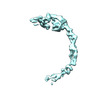



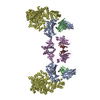
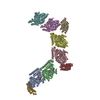
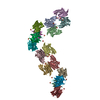
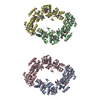















 Z (Sec.)
Z (Sec.) Y (Row.)
Y (Row.) X (Col.)
X (Col.)






































